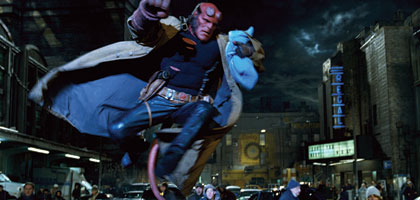Primary navigation

USA/Germany 2008

Reviewed by Michael Atkinson
Our synopses give away the plot in full, including surprise twists.
At the Bureau of Paranormal Research and Defense, blue-collar domesticated demon Hellboy and his associates (among them merman Abe Sapien and human torch Liz Sherman) wrestle with everyday problems as well as with the matter of their covert existence. Thanks to Hellboy's restless exhibitionism above ground, the whole operation is on the verge of going public.
Meanwhile elf prince Nuada, furious about mankind's wasteful dominance of Earth, practises swordplay under Manhattan, in anticipation of recovering the crown fragments that will allow him to wage war against humans. After killing his father the king, who opposed his course of action, Nuada goes public at an artefact auction, where he retrieves the first fragments and slaughters all present. When Hellboy and the BPRD contingent show up at the scene of the massacre, all that remains is a carnivorous swarm of hungry faeries, eventually extinguished by Sherman's incendiary powers.
Nuada searches for the remaining fragment, which is hidden by his twin sister Nuala; Hellboy and his colleagues - including an ectoplasmic vapour-man sent by the government to lead the bureau - follow clues to a secret troll market under the city, where Sapien meets and bonds with Nuala (who accepts the BPRD's protection) and where Hellboy trounces Nuada's giant troll henchman. Nuada unleashes a 'forest god' which wreaks havoc until Hellboy destroys it. Along with the remaining crown piece, Nuala hides a sacred map detailing the whereabouts of the mechanical-magical Golden Army, with which Nuada would be invincible against men. Nuada discovers the army's location anyway, and faces off against Hellboy in an ancient ruined city under Northern Ireland, where the army is awakened and ready to march.
Easily the most enjoyable of recent comic-book movies - if only because it was conceived with a measure of what-the-hell brio and because it dared to mix 90 per cent self-mockery with 10 per cent unpredictable pathos - Guillermo del Toro's original Hellboy (2004) was an everything bagel of monsters-in-New-York irony, personality gags, sploogey hand-to-hand, bleeding hearts, wry patter and poetic parodies of Romantic imagery (Goya, Blake, Fuseli, Géricault). The balance of character-based good humour and misfit melancholy made the action-film junk digestible, allowing us to enjoy the savvy commentary on the ripe cliché cheese commonly served up both in superhero sagas and return-of-Satan thrillers. So it is to a lesser, diminishing-returns degree with this sequel, which repeats the scenario to confront a new legendary creature threat in a random manner that suggests Hellboy could be a weekly TV show, coming up against Mordred, Ravana, the Gorgons, Sauron and Lucifer himself by season's end.
The formula of the first film was hardly so stout that it could survive multiple big-screen exploitations. But you can't blame del Toro or comic creator/co-writer Mike Mignola - today, Hollywood's notion of epic storytelling consists largely of planting successive narrative revelations between a relentless series of digitally enhanced (or, here, entirely digitally constructed) fights. Stories used to involve dramatic choices, character crises and ethical costs. No more. We've arrived at a stage where the explosive coolness of what happens completely obscures the why. (If The Bridge on the River Kwai were to be remade, it'd be all about the bridge blowing up, how it was managed and how it won the whole war. The stories of the doomed ramrod POW colonel and disillusioned American soldier would be neglected subplots, with happy endings.) To say the plot of Hellboy II resembles the glibly passing panels of a comic book says it all - it's less a fully realised film than a succession of graphic gags, be they CGI stunts or CGI creatures (all disarmingly beautiful) or CGI machinery or CGI whatever.
So, it's not great del Toro - the gleeful Mexican's filmography has so far glowed when he's adhered more feverishly to the morally stressed, ordeal-by-imagination realm of folk art (as in Cronos, The Devil's Backbone and Pan's Labyrinth) than to graphic-novel jazziness. There's also no underestimating the gravity those three films acquire via their relationship to Mexican and Spanish history. Gravity is not on a comic-book movie's agenda, physically or thematically. But it's unfair to bludgeon Hellboy II for the crimes of the culture it inhabits - it's a breeze to watch, undemanding of empathy, constantly inventive in its monsters and always ironic. The film's high point is a beer-drunk idyll shared by Ron Perlman's 'Red' and Doug Jones' amphibian, both of them heartsick and crooning along to Barry Manilow's 'Can't Smile without You'.
Hellboy II comes bearing its few moments of poetic ruefulness as gifts amid the cartoon chaos, but far too much of it is aimed like a fire hose at the pimple-faces in the audience. Every scene and every narrative set-up climaxes with big guns and roundhouse punches and figures flying absurdly through the air; several scenes seem cut short by the film-makers' itchy desire to start brawling (every lavish set is wrecked in a mano-a-mano). Grace notes aside, the problem with Hellboy II is that too much of it is sub-literate, and too convinced that flashy physical combat tells stories, rather than stalls them to a halt. It's a universal presumption in modern Hollywood, and audiences have tacitly agreed to forgive pulp movies their bully reflexes. Here's to sending del Toro back to Spain.